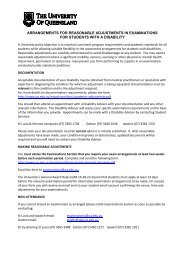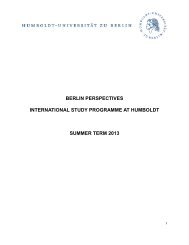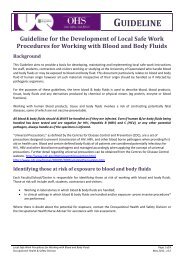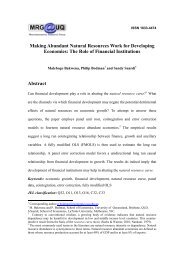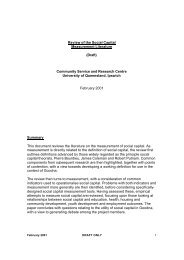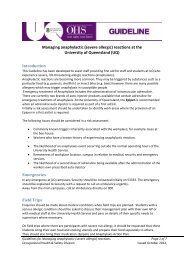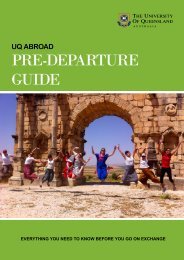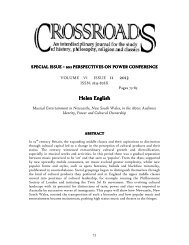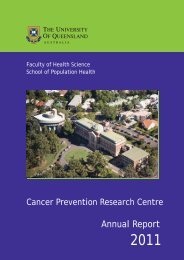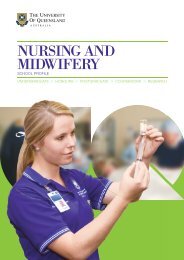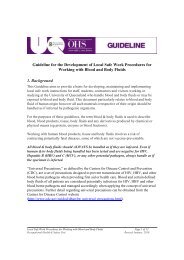Winter 2013 - University of Queensland
Winter 2013 - University of Queensland
Winter 2013 - University of Queensland
Create successful ePaper yourself
Turn your PDF publications into a flip-book with our unique Google optimized e-Paper software.
esearch at UQTargeting the causePr<strong>of</strong>essor Ranjeny Thomas, Head <strong>of</strong> theAutoimmunity division at UQ’s DiamantinaInstitute (UQDI), and her team have developedan innovative vaccine therapy for rheumatoidarthritis, a devastating immunological diseasethat affects millions <strong>of</strong> people around the world.The therapy is unique in that it targetsthe underlying autoimmune cause <strong>of</strong> thedisease, which has been “cooking” for manyyears before it manifests with symptoms <strong>of</strong>inflammatory arthritis.Thomas’s team is investigating howthe vaccine strategy could be applied toother autoimmune diseases, such as type1 diabetes, celiac disease, thyroiditis andmultiple sclerosis.Pr<strong>of</strong>essor Matt Brown, Director <strong>of</strong>UQDI, said genetics research such as thatundertaken by Thomas would lead to earlierdiagnosis and preventative treatments.“Immune-mediated diseases likeinflammatory arthritis and diabetesaffect five to ten per cent <strong>of</strong> Westerncommunities. By developing therapies thatcan ‘turn <strong>of</strong>f’ or block particular pathways,we can potentially diagnose and treatdiseases a lot earlier, which is a hugehealth and economic benefit.”Nanopatch – thinkingoutside the squarePr<strong>of</strong>essor Mark Kendall (Bachelor<strong>of</strong> Engineering ’93, PhD ’98), abiomedical engineer at UQ’sAustralian Institute forBioengineering andNanotechnology and ARC Future Fellow, hasspent the last ten years developing theNanopatch, a leading “needle-free” methodfor delivering vaccines. Kendall came up withthe concept while he was at a scienceconference, with time on his hands and anotepad and pencil.“I was thinking about how we couldimprove the reach <strong>of</strong> vaccines, so I decidedto take a step back and find a different way<strong>of</strong> doing that,” he said.“Being bored in a presentation gave methe scope to think and doodle. My engineer’sinstinct told me that this was somethingimportant.”Kendall’s design is beguiling in its simplicityand ingenuity. A tiny square containinghundreds <strong>of</strong> even tinier projections, eachdry coated with the vaccine, is fired into theimmune “sweet spot”, just below the surface<strong>of</strong> the skin, via a mechanical dispenser.This approach has significant advantagesover the old technology <strong>of</strong> needle andsyringe, which has remained virtuallyunchanged since 1853. Because it uses dryvaccine, the Nanopatch eliminates the needfor refrigerated storage (the so-called “coldchain”), which can be a barrier to massvaccination in many developing countries.It also delivers the vaccine to where it’sneeded most, meaning that only a fraction <strong>of</strong>the usual dose is required. Another advantageis that the Nanopatch can be self-administered.Painless and fast, it eliminates the problems<strong>of</strong> needle phobia and needle-stick injuries.As well as being a pioneer <strong>of</strong> biomedicaland bioengineering innovation, Kendallis a strong advocate for developing ideasbeyond the science. In 2011, he c<strong>of</strong>oundedstart-up company Vaxxas Pty Ltd,garnering investment contributions <strong>of</strong> $15million to commercialise the Nanopatch forwidespread use in humans.In 2012, the Nanopatch achieved anothermilestone on its journey to commercialrealisation, with the announcement <strong>of</strong> asignificant partnership between Vaxxasand US-based pharmaceutical giant Merck,which will see the latter begin commercialproduction <strong>of</strong> vaccines using the Nanopatchplatform in the very near future.In recognition <strong>of</strong> his outstanding success,Kendall was one <strong>of</strong> only five internationalrecipients <strong>of</strong> a prestigious Rolex Laureatein 2012 (selected from a field <strong>of</strong> 3500applicants globally). This award has enabledhis team to commence the application <strong>of</strong>the Nanopatch to the developing world,starting with a usability trial in Papua NewPr<strong>of</strong>essor Mark Kendall demonstrates how the Nanopatchworks to nurses at Port Moresby General Hospital.Guinea (PNG). In this trial, the team isusing the cervical cancer-causing humanpapillomavirus (HPV) as their test case.Globally, cervical cancer claims 270,000lives each year, and PNG has the highestincidence <strong>of</strong> HPV in the world.Kendall said he was even more motivatedto fast-track his work after a recent visit toPNG, where he saw first-hand the humanface <strong>of</strong> many infectious diseases, includingpneumonia and meningitis, in a clinical setting.“It’s confronting and it just made me wantto jump back on the plane, get back to thelab and move the work along,” he said.To follow the Nanopatch’s journey,visit Pr<strong>of</strong>essor Kendall’s page ataibn.uq.edu.au/mark-kendall© Rolex Awards/Julian Kingma.A research programinto pancreatic andovarian cancers led byIMB’s Pr<strong>of</strong>essor SeanGrimmond receives$27.5 million from theNHMRC – its largesteversingle grantThe AtlanticPhilanthropiesannounces a $50million gift to helpestablish Australia’sfirst TranslationalResearch InstituteThe School <strong>of</strong>Pharmacy movesto a new state-<strong>of</strong>the-artfacility, ThePharmacy AustraliaCentre <strong>of</strong> ExcellenceIMB researchers ledby Pr<strong>of</strong>essor DavidCraik engineer anorally active moleculethat could be usedin the treatment <strong>of</strong>neuropathic painThe <strong>Queensland</strong>Children’s MedicalResearch Institutejoins UQ as a centrewithin the Faculty <strong>of</strong>Health Sciences<strong>Queensland</strong>’s firstIndigenous doctor,Associate Pr<strong>of</strong>essorNoel Hayman (’90), isnamed <strong>Queensland</strong>’sAustralian <strong>of</strong> the YearThe Asia-Pacific Centrefor Neuromodulation– a world leaderin brain research –is launched by UQand St Andrew’s WarMemorial Hospital20092009 JUL2010 JAN2010 SEP201020112012UQ Contact WINTer <strong>2013</strong> 17


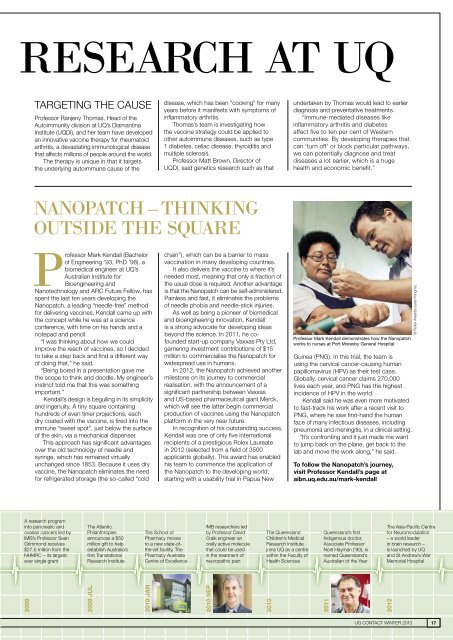

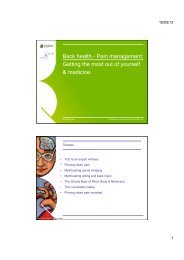
![Recycling [ PDF, 62KB ] - University of Queensland](https://img.yumpu.com/51805185/1/184x260/recycling-pdf-62kb-university-of-queensland.jpg?quality=85)
